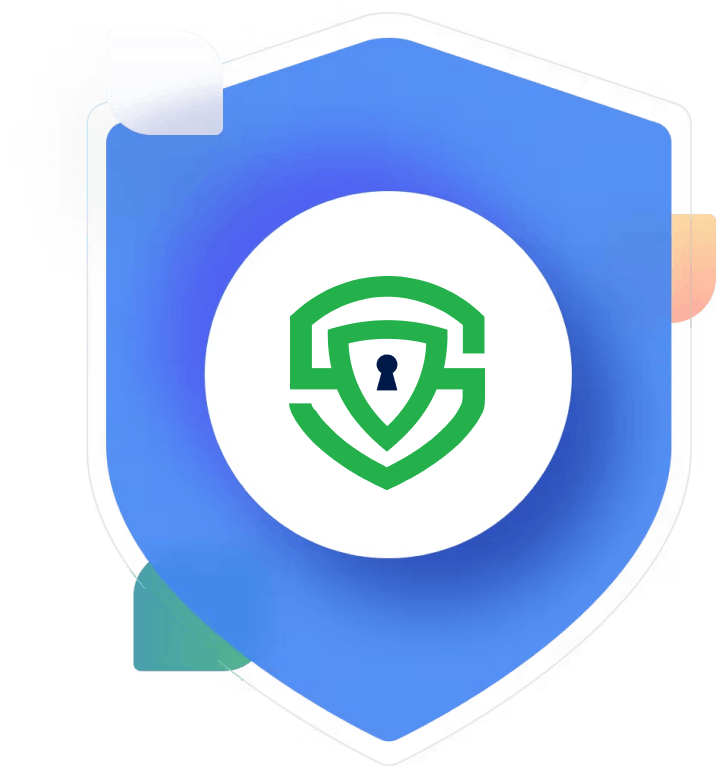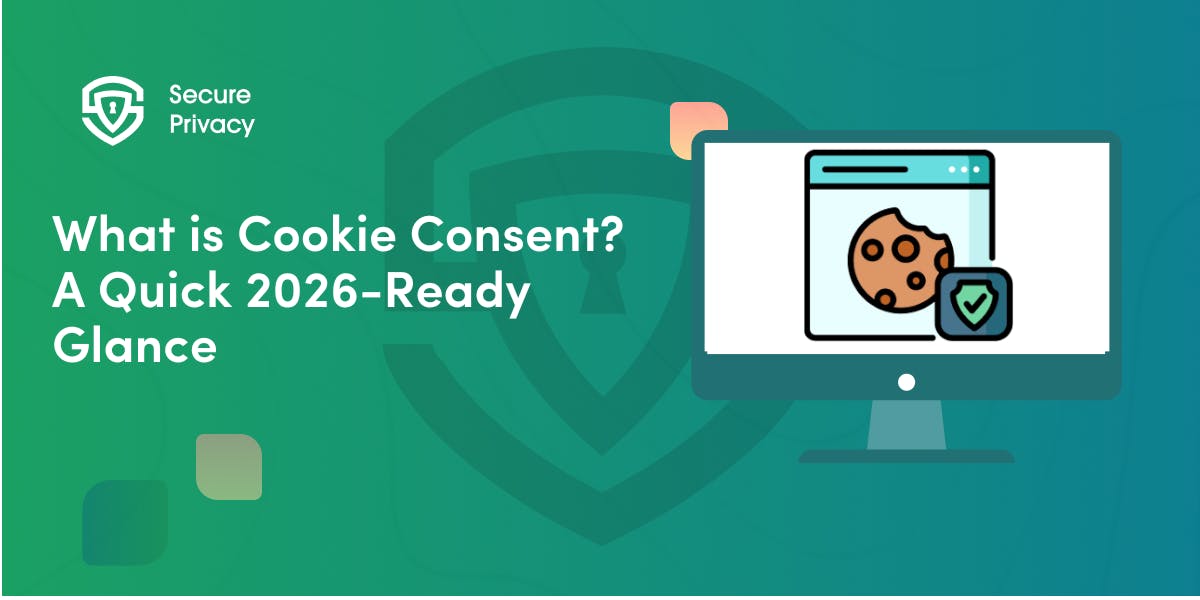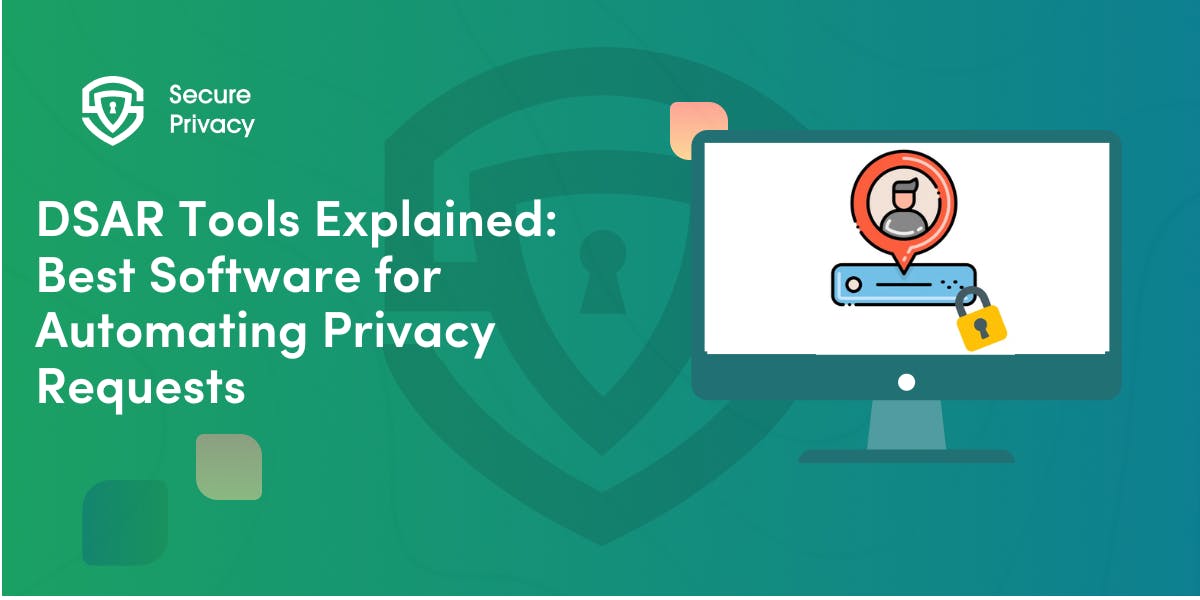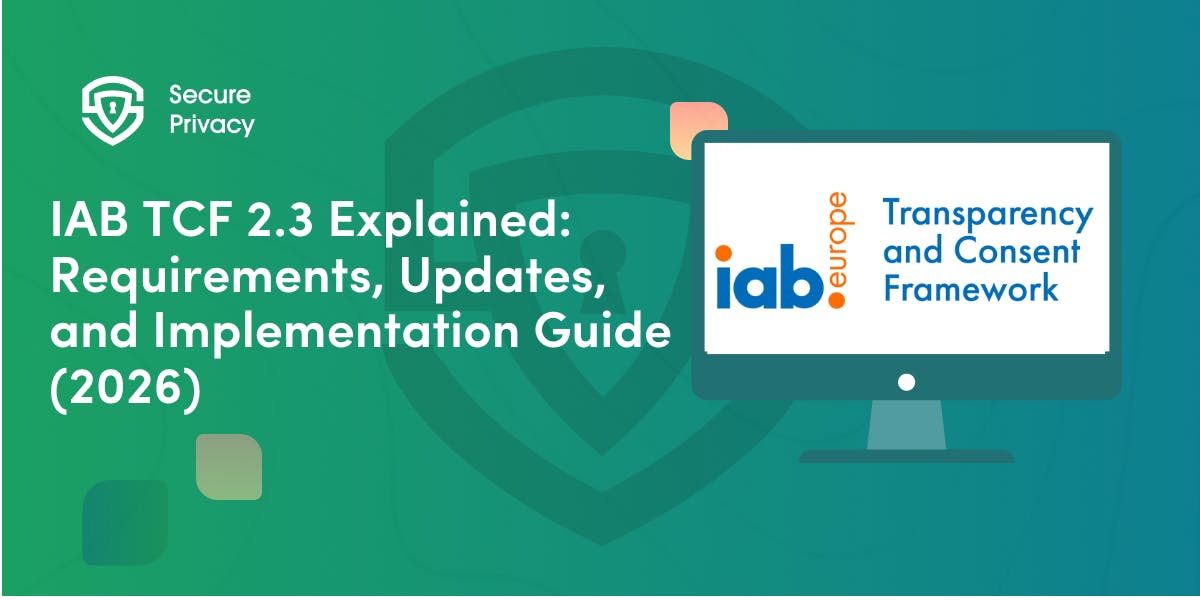Client Consent Lifecycle Automation: Streamlining Compliance & Trust
Client consent is no longer a static checkbox buried in terms of service agreements. Modern privacy regulations demand dynamic, granular, and continuously managed consent processes that adapt to changing preferences, evolving regulations, and complex multi-channel customer interactions
Client consent lifecycle automation transforms fragmented manual processes into streamlined, compliant workflows that reduce risk, build trust, and enable operational efficiency across global privacy frameworks including GDPR, CCPA, HIPAA, and emerging state-level regulations.
Organizations struggling with manual consent management face mounting compliance risks, operational inefficiencies, and eroding customer trust as privacy requirements become increasingly complex and enforcement intensifies across jurisdictions.

Prioritizing user privacy is essential. Secure Privacy's free Privacy by Design Checklist helps you integrate privacy considerations into your development and data management processes.
What Is Client Consent Lifecycle Automation?
Client consent lifecycle automation encompasses the systematic management of every stage in the consent journey through intelligent software platforms. The lifecycle includes initial consent collection, secure storage and versioning, real-time preference updates, voluntary withdrawal processing, and comprehensive audit trail maintenance.
Automated systems ensure each step maintains regulatory compliance while providing transparency and control to clients. Unlike traditional static consent mechanisms, modern automation adapts to changing regulatory requirements, updates consent interfaces based on geographic location, and synchronizes preferences across all organizational touchpoints.
The Complete Consent Lifecycle:
- Collection: Capturing informed, specific, and freely-given consent through optimized interfaces
- Storage: Maintaining tamper-proof records with complete versioning and audit trails
- Management: Processing preference updates, renewals, and granular permission changes
- Withdrawal: Enabling simple revocation with immediate downstream system updates
- Reporting: Generating compliance documentation and audit-ready evidence
Consider a multinational bank automatically updating marketing consent preferences across web portals, mobile applications, email systems, and branch locations when a client modifies their preferences through any single touchpoint. This real-time synchronization ensures consistent customer experience while maintaining regulatory compliance across multiple jurisdictions.
Key Challenges Without Automation
Organizations relying on manual consent processes face significant operational and compliance challenges that compound as business scale and regulatory complexity increase. Inconsistent consent tracking across channels creates compliance gaps where customer preferences collected through one touchpoint fail to propagate to other systems.
Manual processes introduce human error risks that can result in privacy violations, regulatory fines, and customer trust erosion. Teams struggle to maintain accurate consent records, verify withdrawal completeness, and generate audit documentation when regulators demand evidence of compliance practices.
Operational Inefficiencies: Manual consent management consumes significant legal and IT resources for routine tasks including preference updates, audit trail maintenance, and cross-system synchronization. Organizations report spending hundreds of hours annually on consent-related administrative work that automation could eliminate.
Compliance Vulnerabilities: Different jurisdictions require varying consent approaches—GDPR's explicit consent requirements differ significantly from CCPA's opt-out mechanisms and HIPAA's healthcare-specific authorizations. Manual processes struggle to adapt consent collection and management practices based on customer location, data types, and applicable regulations.
Customer Experience Degradation: Fragmented consent management creates frustrating customer experiences where preferences must be updated separately across multiple platforms. Customers lose trust when organizations cannot demonstrate clear understanding of their consent choices or when withdrawal requests aren't processed promptly across all systems.
Audit Preparation Complexity: Manual systems make compliance audits extremely resource-intensive, requiring teams to gather scattered documentation, verify consent validity, and demonstrate systematic privacy practices. Organizations often discover consent gaps only during audit preparation when remediation becomes costly and time-sensitive.
Benefits of Automating Consent Lifecycle
Compliance Assurance and Risk Mitigation
Automated consent platforms provide continuous compliance monitoring that adapts to regulatory changes in real-time. Systems automatically update consent collection mechanisms when new privacy laws take effect, adjust data processing based on evolving requirements, and maintain documentation standards that satisfy regulatory expectations.
Automation significantly reduces compliance risk by eliminating manual errors, ensuring systematic consent validation, and maintaining comprehensive audit trails that demonstrate organizational commitment to privacy protection. Organizations report compliance confidence increases of 60-80% after implementing automated consent management.
Operational Efficiency and Resource Optimization
Automation transforms consent management from a labor-intensive administrative burden into a streamlined operational capability. Legal teams focus on strategic privacy initiatives rather than routine consent administration, while IT resources redirect from manual data management to innovation projects.
Measurable Efficiency Gains:
- 70% reduction in consent-related administrative time
- 85% faster response to customer preference changes
- 90% reduction in audit preparation time
- 50% decrease in privacy-related support tickets
Enhanced Customer Trust and Transparency
Automated platforms enable sophisticated self-service consent portals where customers can view complete consent histories, modify preferences granularly, and receive immediate confirmation of changes across all organizational systems. This transparency builds trust while reducing customer service burden.
Real-time consent synchronization ensures customers see immediate effects of their choices, creating confidence that organizations respect their privacy preferences. Advanced platforms provide consent analytics that help customers understand how their data is used while maintaining complete control over permission levels.
Marketing Personalization and Business Value
Dynamic consent automation enables sophisticated marketing personalization based on explicit customer preferences rather than inferred behavior. Organizations can create targeted campaigns using only data customers have specifically authorized while maintaining detailed documentation of permission scope.
Business Impact: Automated consent management typically improves marketing effectiveness by 25-40% through better audience targeting based on verified preferences. Organizations avoid wasted marketing spend on non-consented audiences while building stronger relationships with engaged customers who have explicitly opted in to communications.
Core Features of a Consent Lifecycle Automation Platform
Centralized Consent Repository
Modern platforms maintain unified consent records that serve as authoritative sources for all customer preferences across organizational systems. The repository stores granular permissions for different data types, processing purposes, communication channels, and third-party sharing scenarios.
Advanced platforms support consent versioning that tracks preference changes over time, maintains historical records for audit purposes, and enables rollback capabilities when needed. Integration APIs ensure all organizational systems query the centralized repository for current consent status before processing customer data.
Multi-Channel Consent Capture
Sophisticated platforms collect consent across all customer touchpoints including websites, mobile applications, customer service interactions, retail locations, and third-party integrations. Consistent consent experiences ensure customers receive identical options regardless of interaction channel.
Channel Integration Capabilities:
- Web portal integration with existing authentication systems
- Mobile SDK for native application consent collection
- API endpoints for customer service representative access
- Offline consent collection with batch synchronization
- Third-party platform integration through webhooks and APIs
Real-Time System Synchronization
Enterprise platforms synchronize consent changes across all connected systems within minutes of customer preference updates. Marketing automation platforms immediately update audience segments, analytics systems adjust data collection scope, and customer service representatives receive current preference information.
Integration Ecosystem: Modern consent platforms integrate with CRM systems (Salesforce, HubSpot), marketing automation (Marketo, Pardot), analytics platforms (Google Analytics, Adobe), email service providers (Mailchimp, Constant Contact), and custom enterprise applications through robust APIs.
Self-Service Consent Portals
Customer-facing portals enable granular preference management through intuitive interfaces that explain data usage clearly while providing complete control over permission levels. Customers can modify consent for specific purposes, view historical changes, and download complete consent records.
Advanced portals support consent scheduling where customers can set future preference changes, temporary consent for specific campaigns, and conditional permissions based on context or data sensitivity levels.
Automated Compliance Workflows
Platforms automatically handle consent expiration, renewal notifications, withdrawal processing, and regulatory requirement updates. Workflow engines trigger appropriate actions based on regulatory frameworks, customer locations, and organizational policies without manual intervention.
Compliance Automation Features:
- Geographic consent rule application based on customer location
- Automatic consent expiration and renewal workflows
- Regulatory update implementation across all customer touchpoints
- Withdrawal processing with comprehensive downstream system updates
- Audit trail generation with tamper-evident logging
Industry Use Cases
Healthcare: HIPAA and GDPR Patient Consent Automation
Healthcare organizations manage complex consent requirements covering treatment authorization, research participation, marketing communications, and data sharing with insurance providers. Automated platforms handle multi-layered consent scenarios where patients may authorize specific treatments while restricting research data usage.
Implementation Example: A multinational healthcare provider automatically manages patient consent across electronic health records, telemedicine platforms, research databases, and marketing systems. When patients modify research participation preferences, the system immediately updates data access controls across all connected research platforms while maintaining treatment-related permissions.
HIPAA compliance requires detailed authorization tracking with specific language and renewal requirements. Automated platforms ensure authorization forms meet regulatory standards, track expiration dates, and process renewal workflows without administrative burden on healthcare staff.
Financial Services: Cross-Border Marketing Consent
Financial institutions operating globally must navigate complex regulatory frameworks where European customers require explicit GDPR consent while US customers may operate under different state privacy laws. Automated platforms apply appropriate consent mechanisms based on customer location and applicable regulations.
Regulatory Complexity Management: Banks automatically adjust consent collection for different product types—investment services may require enhanced disclosure and consent processes while basic banking services operate under different permission frameworks. The platform ensures consistent compliance across all service offerings and geographic markets.
Automated systems handle consent for various purposes including marketing communications, product recommendations, data sharing with partners, and analytics processing. Customers receive granular control over each category while organizations maintain detailed documentation for regulatory compliance.
SaaS and Technology: Global User Base Management
Software companies serving global customer bases face varying privacy requirements across markets while maintaining consistent user experiences. Automated consent platforms adapt to local regulations while providing unified preference management across all product offerings.
Scalability Requirements: SaaS platforms must handle millions of users with dynamic consent preferences that affect feature availability, data processing scope, and third-party integrations. Automated systems ensure consent changes immediately affect user experiences while maintaining detailed audit trails for compliance validation.
Technology companies often integrate multiple third-party services requiring separate consent processes. Automated platforms coordinate consent across all integrations, ensuring users understand data sharing implications while organizations maintain compliance with vendor agreements and privacy regulations.
Agencies: Multi-Client Consent Management
Marketing agencies managing consent across multiple client brands require sophisticated platforms that maintain separate consent pools while providing centralized reporting and compliance oversight. Each client brand operates independent consent processes while agencies maintain oversight capabilities.
Multi-Tenant Architecture: Agency platforms support brand isolation with separate consent repositories, custom privacy policies, and distinct customer communication preferences. Centralized reporting enables agencies to demonstrate compliance across all client engagements while maintaining confidentiality between competitive brands.
Agencies benefit from standardized consent implementation across clients while customizing user experiences to match brand requirements. Automated platforms reduce implementation time for new client onboarding while ensuring consistent compliance practices across all engagements.
How to Evaluate Consent Lifecycle Automation Tools
Scalability and Integration Assessment
Enterprise consent platforms must handle current organizational scale while supporting future growth across geographic markets, product offerings, and customer acquisition. Evaluation should consider platform capacity for consent volume, system integration complexity, and global deployment requirements.
Technical Evaluation Criteria:
- API robustness and integration ecosystem breadth
- Real-time synchronization capabilities across multiple systems
- Geographic deployment options and data residency controls
- Performance characteristics under high-volume scenarios
- Disaster recovery and business continuity capabilities
Compliance Coverage and Regulatory Adaptation
Modern platforms should support current privacy regulations while demonstrating ability to adapt to emerging requirements. Evaluation must consider regulatory coverage breadth, update mechanisms for law changes, and compliance documentation capabilities.
Regulatory Evaluation Framework:
- Current law support (GDPR, CCPA, HIPAA, state-specific regulations)
- Geographic coverage for international operations
- Automatic update mechanisms for regulatory changes
- Audit trail completeness and tamper-evidence
- Regulatory reporting and documentation generation
Transparency and Customer Experience Features
Customer-facing capabilities significantly impact adoption rates and trust building. Platforms should provide intuitive preference management, clear consent explanations, and immediate feedback on preference changes across all organizational touchpoints.
User Experience Assessment:
- Self-service portal functionality and ease of use
- Mobile responsiveness and accessibility compliance
- Multi-language support for global customer bases
- Consent explanation clarity and legal language simplification
- Real-time preference change confirmation across systems
Vendor Support and Implementation Services
Complex consent automation implementations require comprehensive vendor support including technical integration assistance, compliance guidance, and ongoing platform evolution. Evaluation should consider vendor expertise, support responsiveness, and long-term partnership potential.
Support Evaluation Criteria:
- Implementation methodology and project management approach
- Technical integration support and custom development capabilities
- Compliance expertise and regulatory guidance availability
- Ongoing support responsiveness and escalation procedures
- Platform roadmap alignment with organizational privacy strategy
Why Consent Lifecycle Automation Matters for the Future
Regulatory complexity continues increasing as governments worldwide implement comprehensive privacy legislation addressing emerging technologies, cross-border data flows, and consumer protection concerns. Organizations must prepare for dynamic regulatory environments where manual consent processes cannot adapt quickly enough to maintain compliance.
Emerging Regulatory Trends: New US state privacy laws create patchwork compliance requirements where organizations must navigate different consent mechanisms, opt-out procedures, and documentation standards across markets. Automated platforms provide the flexibility needed to adapt to varying requirements without rebuilding consent infrastructure.
Customer Expectation Evolution: Consumers increasingly demand transparency and control over their personal data usage. Future success requires organizations to provide sophisticated preference management capabilities that go beyond basic opt-in/opt-out mechanisms to granular purpose-specific controls.
Technological Integration Requirements: Emerging technologies including artificial intelligence, Internet of Things devices, and advanced analytics require dynamic consent mechanisms that can adapt to new data processing scenarios. Automated platforms provide the foundation for consent management that evolves with technological capabilities.
Organizations implementing consent lifecycle automation today position themselves for future regulatory and technological challenges while building competitive advantages through enhanced customer trust and operational efficiency.
How Secure Privacy Delivers Comprehensive Consent Lifecycle Excellence
Organizations choose Secure Privacy for intelligent consent lifecycle automation that transforms compliance challenges into competitive advantages through industry-leading technology and deep privacy expertise. Our platform combines sophisticated automation capabilities with intuitive user experiences that build customer trust while ensuring regulatory compliance.
Our consent automation solution provides comprehensive lifecycle management including dynamic collection mechanisms, real-time system synchronization, granular preference controls, and audit-ready documentation. Unlike traditional compliance-focused platforms, Secure Privacy emphasizes customer experience and operational efficiency alongside regulatory adherence.
The platform's advanced integration capabilities ensure seamless deployment within existing technology ecosystems while providing the scalability needed for global operations. Our transparent pricing and comprehensive support ensure predictable implementation costs and reliable ongoing operations for organizations at any scale.
Frequently Asked Questions
What is the difference between consent management and consent lifecycle automation? Consent management typically refers to basic consent collection and storage, while consent lifecycle automation encompasses the complete journey including dynamic updates, real-time system synchronization, automated compliance workflows, and comprehensive audit trail maintenance. Lifecycle automation provides ongoing management rather than point-in-time consent capture.
How does automated consent management handle different regulatory requirements across jurisdictions?
Modern platforms use geographic detection and regulatory intelligence to automatically apply appropriate consent mechanisms based on user location and applicable privacy laws. The system maintains different consent templates, processing rules, and documentation requirements for each jurisdiction while providing unified management interfaces.
Can consent lifecycle automation integrate with existing CRM and marketing systems?
Enterprise consent platforms provide robust APIs and pre-built integrations with popular CRM systems (Salesforce, HubSpot), marketing automation platforms (Marketo, Pardot), and analytics tools (Google Analytics, Adobe). Real-time integration ensures consent changes immediately affect all connected systems.
How do customers access and modify their consent preferences in automated systems?
Automated platforms typically provide self-service portals where customers can view complete consent histories, modify granular preferences, and receive immediate confirmation of changes. Advanced systems support mobile applications, email-based preference centers, and customer service representative access for comprehensive preference management.
What audit documentation do consent lifecycle automation platforms provide?
Comprehensive platforms maintain tamper-evident audit trails documenting all consent interactions including timestamps, IP addresses, consent mechanisms used, preference changes, and withdrawal processing. This documentation supports regulatory audits, legal proceedings, and internal compliance validation.
How do automated systems handle consent withdrawal and data deletion requirements?
Withdrawal processing triggers automated workflows that immediately update all connected systems, suppress marketing communications, adjust analytics data collection, and initiate data deletion procedures where required. The platform maintains documentation of withdrawal processing and deletion completion for compliance verification.
Ready to transform your organization's approach to consent management through intelligent lifecycle automation? Request a demonstration of our comprehensive consent automation platform to see how streamlined compliance can enhance customer trust while reducing operational complexity. Download our Consent Lifecycle Automation Guide to evaluate your current processes and identify optimization opportunities.
Get Started For Free with the
#1 Cookie Consent Platform.
No credit card required

What is Cookie Consent? A Quick 2026-Ready Glance
Your website loads. Cookies track users. But without proper cookie consent, you're violating GDPR — risking fines up to €20 million or 4% of global revenue. Cookie consent is the legally required mechanism by which websites obtain explicit user approval before deploying non-essential tracking technologies. This requirement stems from GDPR Article 4(11) and the ePrivacy Directive, mandating that consent must be freely given, specific, informed, and unambiguous.
- Legal & News

DSAR Tools Explained: Best Software for Automating Privacy Requests
You're drowning in data subject access requests. Manual searches through dozens of systems miss regulatory deadlines and expose organizations to fines starting at $2,500 per violation. The solution? DSAR tools — purpose-built software that automates the entire process of responding to data subject access requests, from intake to delivery.
- Legal & News

IAB TCF 2.3 Explained: Requirements, Updates, and Implementation Guide (2026)
Your ad revenue dropped 40% overnight. Google stopped bidding on your inventory. Your DSP partners flagged your traffic as non-compliant. The culprit? An outdated TCF 2.2 consent string after the February 2026 enforcement deadline.
- Legal & News
- Cookie Consent
